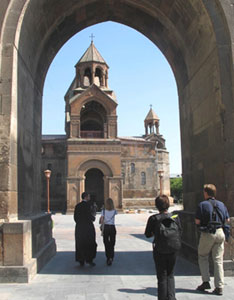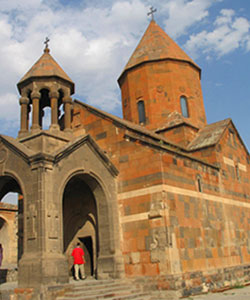
By Susan McKee
Standing in Republic Square, I could imagine myself anywhere in Europe.
To my right was a sidewalk café filled with smartly dressed men and women sipping coffee and talking on cell phones.
In front of me, pedestrians expertly dodged the fast-moving taxis, trucks and cars streaming past.
But when I looked at the signs in the grocery shop window down the street, I suddenly realized I couldn’t read it, or even recognize the alphabet. The architecture of the monumental government buildings around the square was an odd and unfamiliar style.
Welcome to Yerevan!
Welcome to Yerevan! This cosmopolitan city melds the expected with the alien. There’s an old saying that the Armenians have their minds in the west and their hearts in the east.
Perched on the cultural boundary between Europe and Asia, the capital of Armenia is an ideal destination for the traveler who is looking for the exotic in a familiar setting.
It’s estimated that there are nine million Armenians in the world, but only one third live in their homeland – a country much smaller than its historic reach. Today it is bordered on the north by Georgia, on the east by Azerbaijan, and on the south and west by Iran and Turkey.
Historic Armenia

Two thousand years ago, Armenia stretched from the Mediterranean to the Caspian seas, but centuries of defeats have moved the boundaries inward. In the years around World War I, hundreds of thousands of Armenians died or emigrated.
Most, here or abroad, are members of the Armenian Apostolic Church, a Christian denomination dating to AD 301 (three decades before the Emperor Constantine declared Christianity the state religion of Rome).
During the Soviet era, churches were closed or destroyed, but since independence, there has been a resurgence of interest in “the faith of our fathers”. The countryside is dotted with ancient stone churches open to tourists.
Armenia declared its independence from the Soviet Union in 1991, and in recent years, the economic development has been nothing short of astonishing. Armenians of the diaspora have poured money and talent into the homeland of their ancestors.

They have done everything from developing a modern highway system to opening western-style hotels at a rapid pace. Many have moved to Yerevan to teach or start businesses.
Cascade Gallery
Gerard L. Cafesjian, an Armenian-American businessman, is finishing the Cascade. Begun during Soviet times, this combination garden, fountain and sculpture gallery stair steps some 30 stories up the steep hill to the north of downtown Yerevan.
Already, works by sculptors including Fernando Botero are in place alongside elaborate flowerbeds. When the project is completed, Cafesjian’s personal collection of contemporary art will be installed in a museum placed at the top of the white granite structure.
Visitors don’t have to climb the 553 steps, however. A series of escalators is hidden on the left side of the Cascade, and there’s no charge to ride up or down.
The entrance to Victory Park is across the street from the museum location at the top of the Cascade.

The massive statue of Mother Armenia, visible from almost everywhere in Yerevan, is at the eastern edge of the park, which also has a Ferris wheel and old-fashioned carnival games.
Mount Ararat
Viewed from the park on a clear day, Mount Ararat seems close enough to touch. The Armenians consider themselves to be the descendants of Noah, whose ark famously beached on Ararat’s peak after the flood.
This fabled mountain is the historic heart of the ancient Armenian empire, and the fact that it lies across the border in Turkey is a touchy subject.
The Matenadaran (manuscript library) houses the illuminated manuscripts from Armenia’s medieval culture, and guides are available to explain its collections.

The massive gray basalt building, erected in the 1950s, looms over Mashtots Boulevard, named for the monk who devised the Armenian alphabet in the fifth century (in order to translate the Bible).
Almost all of the Muslims in Armenia left during its war with majority-Muslim Azerbaijan a decade ago.
The only remaining mosque in Yerevan, Gök-Jami (built in 1765) was recently restored with grants from the Iranian government. Visitors can see the fine tile work of the portal and minaret along Mashtots Boulevard.
English-language escorted tours of Yerevan and the surrounding countryside are readily available.
The Genocide Memorial and Museum at Tsitsernakaberd gives dramatic testimony about the 1915 destruction of the Armenian communities of Eastern Anatolia by forces of the Ottoman Empire.
That genocide remains fresh in the memory of many, and the eternal flame in the memorial is usually surrounded by fresh flowers brought by visitors.

English-language signage in the museum, completed in 1995, provides an introduction to the catastrophic event on the eve of World War I.
Armenian Apostolic Church
Echmiadzin is the seat of the Armenian Apostolic Church. Ancient khatchkars (stone crosses) and other religious monuments fill the complex, which includes the official residence of the Catholicos, the head of the church.
Although much of the church’s wealth “disappeared” during the Soviet era, enough of the gold and gemstones remain to make a visit to the cathedral’s treasury worthwhile.
Garni, site of a restored pagan temple, and Geghard Monastery, a UNESCO World Heritage Site, are near each other a short distance east of the capital.
To the south is Khor Virap, where St. Gregory the Illuminator was imprisoned in 288 AD for preaching Christianity. He spent 13 years locked in an underground pit until he miraculously cured the king of some disease and, in gratitude, the king was converted.

The pit itself is still preserved in the monastery complex. Intrepid visitors climb down the 27 rungs of a metal ladder bolted to one side of a narrow shaft into the underground room where the saint said he was sustained by angels.
Want to go?
Because of the influx of western capital, there are increasing numbers of western-style hotels in the capital. The first American-branded hotel in Armenia, the Yerevan Marriott, is centrally located on Republic Square. Rooms start at about $145, and the hotel can arrange for airport pickup.
Information about Yerevan and all of Armenia (including Nagorno Karabakh) is available from the Armenian Tourism Development Agency.
- Sicily’s Special Places: Here are Five Favorites - March 12, 2020
- A Summer Cruise in the High Arctic - September 26, 2019
- The Tangled Cultures of Goa, India - March 8, 2019





